It seems like more often than not, the term “rust-free” can rarely be used to describe a vintage Japanese vehicle. How many of us have found what we thought would be a great example and then we see it in person and are disappointed in the amount of work that it will need to repair all of the rust. That doesn’t appear to be the case with this 1974 Toyota Hilux pickup that’s listed here on eBay. This one can be found in Burney, California with bids of $3,250 and there is no reserve.
My first thought was that the cab has been repainted, but I’m guessing that the cab and bed weren’t painted at the same time and maybe not even in the same country. They say that it has the original paint, which it most likely does, but some of these trucks came to the US sans truck box, as no Toyota Hilux owner said, ever. Then, US-made beds were attached here in order to get around the 25% Chicken Tax. That probably ‘splains the color difference.
But, no rust is no rust and that’s as good as it gets in the vehicle world for me. I can deal with almost anything but extensive rust. Ok, enough with the rust talk! Just one more thing: this truck has ZERO rust! Sorry, but even the seller stresses that amazing fact. Inside the bed looks solid and clean (and, no rust). For the record, Hilux, or HiLux = High Luxury, but they weren’t really that luxurious.
The interior is fairly beaten up, or more accurately, the sun has wreaked havoc with the soft parts here as you can see. The seller says that this truck is originally from dry, southern Oregon, and has spent all of its time there since new. It’s now located in Burney, California about two hours south of the Oregon border so I’m not quite sure what the timeline of ownership has been.
The engine and engine compartment sure look original, or at least unrestored. This is Toyota’s 18R, a 2.0L inline-four with just over 100 hp. The seller says that it drives and shifts beautifully and for fans of original, rust-free small pickups, it may not get much better than this.





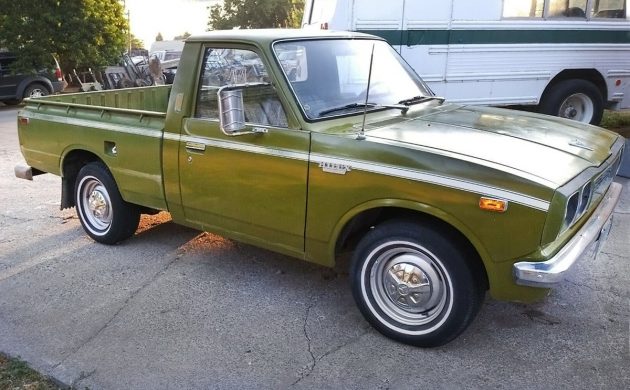

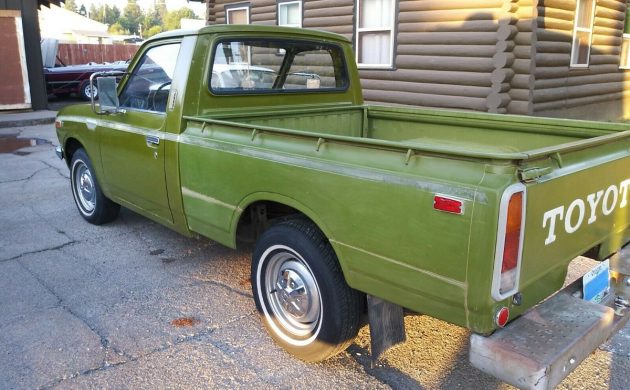
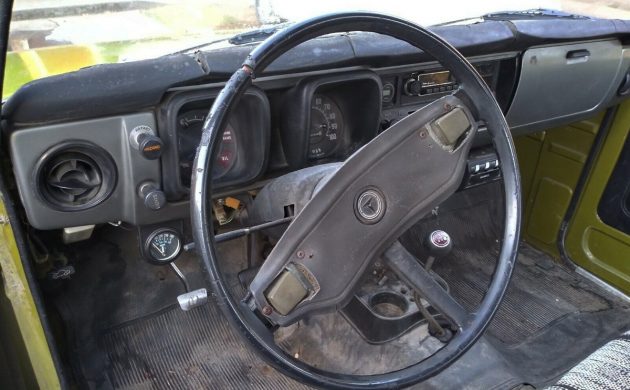


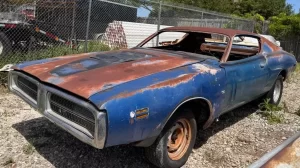

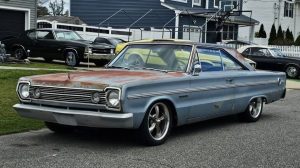


I grew up in a family with a Toyota dealership, and never really knew that this was the case with the bed, not that it was brought up, but regardless, if that was the case with the American made beds, you’d think that they would of tooled the sheetmetal to match the body of the truck. These were pretty dependable vehicles, and as far as I’m concerned, we need to ditch our “bigger is better” mentality and bring back the mini pickups!
Read up on the Chicken Tax. That will explain the beds being made in the US.
Bob S,I couldn’t agree more. My last pu was a ’93 Toyota short bed that I bought new and when I sold it it looked amazing in and out. (I had it 24 years. I’d like to buy a no frills pick up but they just aren’t there anymore.
Agreed. Nothing worse that a parking lot full of Ford150
I worked at a Toyota dealership as well , and saw some differences in paint as they got older. I seem to remember though, that the beds with the hooks on the sides were Japanese built and shipped in, while U.S. beds dd not have the hooks . Either way, they disintegrated here in the Northeast due to the salt and snow .
I’ve had a couple of older Toyota trucks & I’ve noticed frequent differences over time in the factory paint of the cab vs the bed.
I also have noticed that the cabs seemed to be rust-proofed better than the beds.
…I had an ’87 that had a cab without one speck of rust and a bed that was rusted badly (not thru, but still enough to require cutting/grinding to repair) along the mid-side seams.
Not sure about the assumption that the beds were made in the US to escape the “chicken tax” though.
At one point in time I do remember some of the base trucks had beds that were different than the higher trim level trucks. The base trim trucks still had the hooks along the outer bed rails, whereas the more deluxe trucks had bed side profiles that blended in with the top rail & no hooks.
I just checked on the Toyota USA web page.
It states there:
“1971: Atlas Fabricators of Long Beach is signed to produce truck beds for pickups, marking Toyota’s first U.S. production (name later changed to TABC)”
…
https://www.toyota.com/usa/operations/timeline.html
Ford imported the Mazda Courier, and Chevy imported the LUV, as bed-less chassis cabs in order to get around the chicken tax. The rules on the chicken tax were changed in 1980 or so to eliminate that particular dodge. After that Ford started manufacturing the Ranger in the US.
Ford did this with the Transit Connect. Built in Turkey, they would import them with back seats and windows so they could come in as a car. Once they landed on US soil they pulled the back seats and sent them back to the plant in Turkey and plugged the windows.
My brother bought one of these brand-new in 1973, same “godawful green” (my description, not Toyota’s). 1st 4 wheeled vehicle I drove with a stick !
Nice truck! Paint the bed to match the cab instead of Amoxicillin green and drive it!
Scotty, you’re right about the beds. From memory, I believe the import trucks shipped here without the beds attached allowed for skipping a certain tariff that was in place at that time.
I recall seeing photos of hundreds of Japanese truck beds being shipped vertically and they were to be installed at the port of entry.
Here is a link to an old photo of hundred’s of “bed-less” trucks at a port.
https://hosting.photobucket.com/albums/aa40/steroid620/many620_zps068b5a85.jpg
From what is on the web, apparently the US applied a 25% tariff on imported “trucks” to lessen competition. It is still in place. Perhaps removing the bed changed the classification. Someone must have been around then to shed light on this practice. Anyone?
Many folks don’t know it, but Japan applies a 100% of sticker price tariff, as well as a 10% quota on total sales of imported vehicles sold there. This guarantees their domestic manufacturers 90% of their own market, protecting their manufacturing jobs. Trade needs to be done on a level playing field, thus the U.S. needs to do the same thing here for it to be fair.
I’ll tell you what – as soon as Ford, GM or Chrysler can build a small simple truck like my Toyota that will go half a million miles with only basic maintenance and a few simple repairs and still be 100% rattle and noise free with virtually everything still working as intended, then we can talk about being protective of the domestic industry. I may very well take this truck on a long trip and rack up another 4,000 miles within the next few weeks. What 23 year old Ford Ranger or Chevy S10 will do that?
What a bunch of BS. Toyota began buying back total rusted out small pick ups in the early 2000s. My brother had a 1995 Tacoma. While mechanically far superior to any American POS, the frame rotted and broke in two. Toyota gave him a $10,000 credit toward a New 2008 Tacoma. Guess what that frame rotted as well. Everyrhing is made to wear out.
I remember the Toyota rust recall – I owned a 1998 Tacoma and was living in Oregon but it had no rust so Toyota owed me nothing. I still have and drive the truck daily – it clicked 485,235 miles yesterday. Still no rust.
I bought a new discounted 1978 5 speed because the dealer would get one new redesigned 1979 for every 1978 sold. The bed had a sticker on the front reading “Long Beach Metal Fabricators” Mine was white, my friend’s was brown. At least his hid the rust on the horizontal seam of the bed.
I sold mine when it was maybe 3 years old, after I discovered rust bubbles in the right side A pillar.
I later had a Nissan Hardbody for 12 years in the same climate with no rust.
As of ten years ago the “Chicken Tax” was still in play. I had never heard of it so learned the hard way – I had imported a British built1952 Armstrong-Siddeley “Coupe Utility” (fancy name for a very fancy looking truck) from Australia and thought I’d only have the 2.5% duty I paid on virtually everything else I ever imported but suddenly got hit with a 25% tax when I showed up at the Customs office. I have never imported another truck since.
overrated Toyota rust bucket
Another “chicken tax strategy” – Subaru BRAT!
Bed seems to be from a different year than the cab, as body lines are not the same on both. Have seen hundreds of these trucks over the decades, and all have had matching body styles between bed and cabs. Something is fishy here.
No, that bed’s correct.I had a ’72-1/2 RN22 that I bought
from our next door neighbor.It needed four valve jobs within
62,000 miles.It had the 18RC engine.
I swore I’d never buy another Toyota,until I drove a ’76 SR5 Longbed.
I bought one new in ’77.
So does it have any rust. :) sorry.